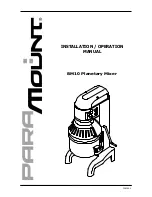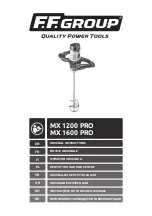
DSP5D GENERAL SPECIFICATIONS
Internar Signal Processing
32-bit (Accumulator 58-bit)
Sampling Frequency
Internal
44.1kHz, 48kHz, 88.2kHz, 96kHz
External
Normal rate: 44.1kHz — 48kHz
Double rate: 88.2kHz — 96kHz
Signal Delay
Less Than 2.5ms INPUT to OMNI OUT (@ Fs = 48kHz)
Less Than 1.25ms INPUT to OMNI OUT (@ Fs = 96kHz)
Total Harmonic Distortion*
2
Less Than 0.05% 20Hz - 20kHz @+4dBu into 600
Ω
Input Gain = Min.
INPUT 1 — 48ch to OMNI OUT 1-24ch
(@ Sampling frequency = 44.1kHz or 48kHz)
Less Than 0.05% 20Hz - 20kHz @+4dBu into 600
Ω
INPUT 1 — 48ch to OMNI OUT
(@Sampling frequency = 96kHz)
Frequency Response
1.0, -3.0dB 20Hz — 20kHz @1kHz into 600
Ω
INPUT 1 — 48ch to OMNI OUT
(@ Sampling frequency = 44.1kHz or 48kHz)
1.0, -3.0dB 20Hz — 40kHz @1kHz into 600
Ω
INPUT 1 — 48ch to OMNI OUT
(@ Sampling frequency = 96kHz)
Dynamic Range*
3
110 typ. DA Converter (OMNI OUT)
(@ Sampling frequency = 44.1kHz or 48kHz)
108 typ. AD + DA (to OMNI OUT)
GAIN; Min., PAD: ON (@ Sampling frequency = 44.1kHz or 48kHz)
110 typ. DA Converter (OMNI OUT)
(@ Sampling frequency = 96kHz)
106 typ. AD + DA (to OMNI OUT)
GAIN; Min., PAD: ON (@ Sampling frequency = 96kHz)
Hum & Noise*
1
-128dBu Equivalent Input Noise (20Hz - 20kHz)
Rs=150
Ω
, Input Gain = Max.
-86dBu Residual Output Noise, OMNI OUT
Crosstalk @1kHz
Power Requirements
300W, AC 100 — 240V 50/60Hz
Dimensions W x D x H (mm) 480 x 460 x 440 (11U) + 13 (leg)
Net Weight
38kg
Operation free-air Temperature Range
10 — 35˚C
Storage Temperature Range
-20 — 60˚C
Accessories
D-sub 68pin cable 10m x 2
22
23
5. Opera House with Orchestra Pit and Stage DSP5D Units
In this system, which is designed primarily for an opera-house type situation, one DSP5D unit is located in the orchestra
pit while the second DSP5D unit is located on stage. A DCU5D is connected to the console at the rear of the house via
D-sub 68-pin cables. That DCU5D then connects to the first DSP5D unit via a single CAT5 cable. A second DSP5D unit is
connected to the first DSP5D via a second DCU5D using D-sub 68pin cable and CAT5 cables, as shown in the diagram.
This makes 48 microphone/line inputs available in the orchestra pit, and another 48 microphone/line inputs available
on stage. The DSP5D head amps can be controlled directly from the PM5D V2 console. A pair of DME64N units
connected to the stage DSP5D outputs perform processing and distribution for the FOH speakers, box-seat speakers, and
a back-stage speaker system. The orchestra pit DSP5D directly feeds powered monitors for the musicians in the pit.
(male)
(female)
CAT5 Cable
D-sub 68pin (male) Cable
D-sub 25pin (male) Cable
XLR Cable
Speakon Cable
PM5D (RH)
OUT
CASCADE IN
CASCADE IN
CASCADE
CASCADE IN
OUT
CASCADE IN
DSP5D-1
DCU5D-1
Stage
Ochestra Pit
T5n
DME64N
AMP Rack
Dressing Room
IS1218
IF2115
IS1218
IF2115
AVIOM 16/o-Y1
IF2108
MY8-DA96
T5n
DSP5D-2
DCU5D-2
PM5D V2, PM5D-RH V2 GENERAL SPECIFICATIONS
All faders are nominal when measured. Output impedance of signal generator:150
Ω
Internal Signal Processing
32-bit (Accumulator 58-bit)
Sampling Frequency
Internal
44.1kHz, 48kHz, 88.2kHz, 96kHz
External
Normal rate: 44.1kHz — 48kHz
Double rate: 88.2kHz — 96kHz
Signal Delay
PM5D
Less Than 2.3ms INPUT to STEREO A, B (@ Fs = 48kHz)
Less Than 1.15ms INPUT to STEREO A, B (@ Fs = 96kHz)
PM5D-RH
Less Than 2.5ms INPUT to STEREO A, B (@ Fs = 48kHz)
Less Than 1.25ms INPUT to STEREO A, B (@ Fs = 96kHz)
Fader
Moterized, Stroke: 100mm All Faders
Fader Resolution
+10 — -138, -
∞
dB All Faders
Total Harmonic Distortion*
2
Less Than 0.05% 20Hz — 20kHz @+4dBu into 600
Ω
INPUT 1 — 48ch to STEREO A,B OUT (@Sampling frequency = 44.1kHz or 48kHz)
Input Gain = Min.
Less Than 0.05 % 20Hz — 40kHz @+4dBu into 600
Ω
INPUT 1 — 48ch to STEREO A,B OUT (@Sampling frequency = 88.2kHz or 96kHz)
Frequency Response
PM5D
0.5, -1.5dB 20Hz — 20kHz @1kHz into 600
Ω
INPUT 1 — 48ch to STEREO A,B OUT
(@Sampling frequency = 44.1kHz or 48kHz)
0
0
6
o
t
n
i
z
H
k
1
@
z
H
k
0
4
—
z
H
0
2
B
d
2
-
,
5
.
0
Ω
INPUT 1 — 48ch to STEREO A,B OUT
(@Sampling frequency = 88.2kHz or 96kHz)
PM5D-RH
1.0, -3.0dB 20Hz — 20kHz @1kHz into 600
Ω
INPUT 1 — 48ch to STEREO A,B OUT
(@Sampling frequency = 44.1kHz or 48kHz)
1.0, -3.0dB 20Hz — 40kHz @1kHz into 600
Ω
INPUT 1 — 48ch to STEREO A,B OUT
(@Sampling frequency = 88.2kHz or 96kHz)
Dynamic Range*
3
110 typ. DA Converter (STEREO A, B OUT)
(Max. level to noise level)
(@Sampling frequency = 44.1kHz or 48kHz)
108 typ. AD + DA (to STEREO A, B OUT),
GAIN: Min., PAD: ON (@Sampling frequency = 44.1kHz or 48kHz)
110 typ. DA Converter (STEREO A, B OUT) (@Sampling frequency = 96kHz)
106 typ. AD + DA (to STEREO A, B OUT),
GAIN: Min., PAD: ON (@Sampling frequency= 88.2kHz or 96kHz)
Hum & Noise*
1
-128dBu Equivalent Input Noise (20Hz — 20kHz) STEREO A, B OUT
Rs = 150
Ω
-86dBu Residual Output Noise, ST Master Off.
Input Gain = Max.
Input Pad = 0dB
Input sensitivity = -60dB
Maximum Voltage Gain
84dB INPUT 1 — 48 to STEREO A, B OUT, Rs = 150
Ω
, Input Gain: Max., PAD: Off
@1kHz
84dB INPUT 1 — 48 to MIX OUT/MATRIX OUT/CUE OUT/MONITOR OUT
(via STEREO Bus)
Crosstalk
-100dB*
4
, -80dB adjacent input channels
@1kHz
-100dB*
4
, -80dB input to output
Power Requirements
PM5D
480W DC 24V 20A (Use PW800W Only)
PM5D-RH
528W DC 24V 22A (Use PW800W Only)
Dimensions W x D x H (mm)
1551 x 950 x 283
Net Weight
PM5D: 98kg, PM5D-RH: 97kg
Operation free-air Temperature Range
10 — 35˚C
Storage Temperature Range
-20 — 60˚C
Accessories
Goothneck Lamp x 3, Power Supply cable (3.6m), Cover
*
1
Hum & Noise is measured with a 6dB/octave filter @12.7kHz; equivalent to a 20kHz filter with infinite
dB/octave attenuation.
*
2
Total Harmonic Distortion is measured with a 18dB/octave filter @80kHz
*
3
Dynamic range is measured with a 6dB/octave filter @12.7kHz; equivalent to a 20kHz filter with infinite
*
4
Crosstalk is measured with a 30 dB/octave filter @22 kHz
dB/octave attenuation.
LIBRARIES
Name
Number
Total
Scene Memory
Preset 1 + User 500
501
Input Patch Library
Preset 1 + User 99
100
Output Patch Library
Preset 1 + User 99
100
Input Channel Library
Preset 1 + User 199
200
Output Channel Library
Preset 1 + User 199
200
Input EQ Library
Preset 40 + User 159
199
Output EQ Library
Preset 3 + User 196
199
GATE Library
Preset 4 + User 195
199
COMP Library
Preset 36 + User 163
199
Effect Library
Preset 55 + User 144
199
GEQ Library
Preset 1 + User 199
200
HA Library
Preset 1 + User 199
200
PW800W GENERAL SPECIFICATIONS
Power Requirements
1000W (Max.), 100 — 240V, 50/60Hz
Dimensions
W x D x H (mm)
480 x 355 x 132 (3U)
DC Output
Voltage
24V
Current
23A (Max.)
Net Weight
10kg
Operation Temperature Range
10 — 35
°
C
Storage Temperature Range
-20 — 60
°
C
PW800W OUTPUT SPECIFICATIONS
Output Terminal
Format
Level
Connector
DC OUTPUT
—
DC 24V
JL05-2A22-14PC 24pin (Male)
DCU5D GENERAL SPECIFICATIONS
Sampling Frequency
Nomal rate; 44.1kHz - 48kHz
Double rate; 88.2kHz - 96kHz
Power Requirements
12W, 100-240V 50/60Hz
DC IN; XLR-4-32 type (4pin=+12V, 1pin=GND), 11.4V-15V, 1.5A
Dimensions W x D x H (mm)
480 x 150 x 44
Net Weight
2.3kg
Operation free-air Temperature Range
10 — 35
°
C
Storage Temperature Range
-20 — 60
°
C
IF2108
IF2108
IF2108
IF2108
IF2108
HEADPHONE
AVIOM A16-II
HEADPHONE
AVIOM A16-II
HEADPHONE
AVIOM A16-II
*
1
Hum & Noise is measured with a 6dB/octave filter @12.7kHz; equivalent to a 20kHz filter with infinite
dB/octave attenuation.
*
2
Total Harmonic Distortion is measured with a 18dB/octave filter @80kHz
*
3
Dynamic range is measured with a 6dB/octave filter @12.7kHz; equivalent to a 20kHz filter with infinite
*
4
Crosstalk is measured with a 30 dB/octave filter @22 kHz
dB/octave attenuation.
-100dB*
4
, -80dB adjacent input channels
-100dB*
4
, -80dB input to output
































